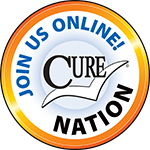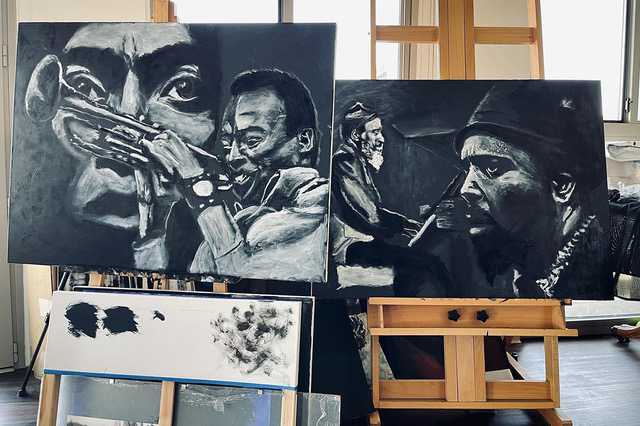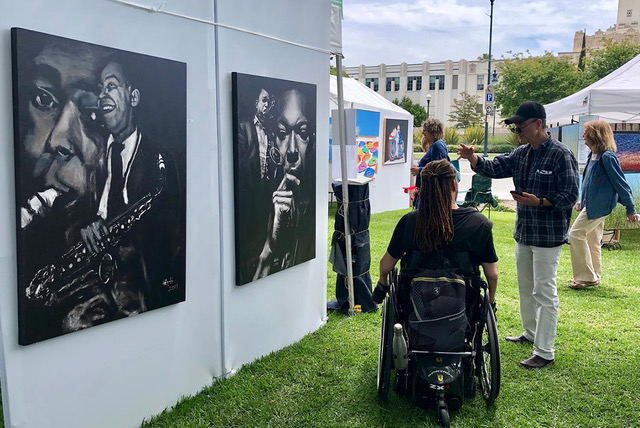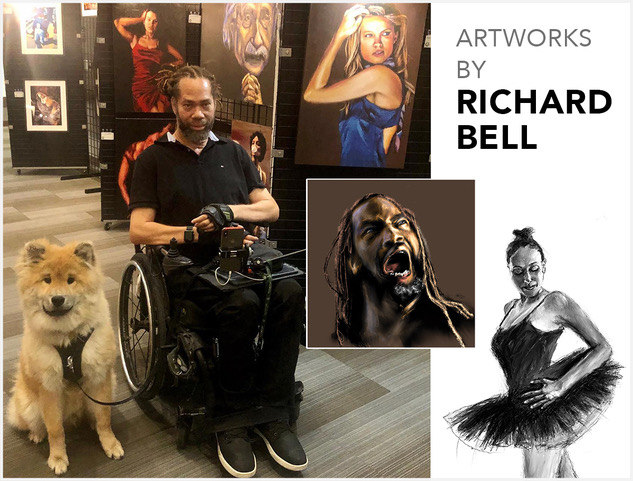 CURE NATION: I’ve known Richard Bell for many years. I saw him at social events, fundraisers, and the occasional support group. I also knew he was involved in a non-profit organization famous for its podcasts serving the extended disability community. What I didn’t know is that Richard is an extremely talented artist!
CURE NATION: I’ve known Richard Bell for many years. I saw him at social events, fundraisers, and the occasional support group. I also knew he was involved in a non-profit organization famous for its podcasts serving the extended disability community. What I didn’t know is that Richard is an extremely talented artist!
Imagine my surprise when, while at my girlfriend’s art reception, I look around the gallery and see Richard near stunning black and white portraits of famous musicians! Gradually, I realize that he is the one who painted them! I wanted to know more.
The fact that Richard is a C-5 quadriplegic means that holding a paintbrush might be his first challenge. “I found that sticking the paintbrush handle into my regular wheelchair gloves worked pretty well. I know that some people hold the paintbrush in their mouths, but I like to use charcoal and that…” Richard pauses as we both picture it, “…wouldn’t work too well.”
His paintings are intense. You can see the extensive personal reflections of both the subject that Richard is capturing, and that person’s creative process.

Richard Bell’s Studio
“Right now, I’m doing motion studies, expression studies.” Richard explains. “One of them is called Unmasked. This is new territory for me. I’m trying to do it so her face is moving, one side with a mask, one side without. I’ve already taken her picture, so that’s my reference. The rest is just…” he trails off. “It’s hard to explain.”
Richard has always appeared to me to be even-tempered, a man in balance, so I am not surprised when he describes the aftermath of his 2002 convertible crash in an even, practical tone:
A Story of Success
“The reason I’m able to do what I do is… well, after you get injured, you’re super confused, you’re in a completely new body, you don’t know what you’re capable of.”
“For me, what worked was getting out and being around other people. You quickly find out there aren’t that many limitations.”
Stairs, well ok, but really not that much.”
I ask about the transition from his old life of working with computers, playing piano and travel, to life in the chair. After the crash, what did he want to do?
“I didn’t want to go back to work, that’s for sure.” Richard states dryly. “I used to have to travel a lot, I was in a different hotel 3 days a week, so I’d bring a sketch pad and charcoal.
I hung out with my great uncle in Oakland for a year. He got me into painting. He taught me everything without teaching me anything, you know.
“Initially I tried doing sketches, but I was really weak. I could only draw for 5 minutes at a time and that was really frustrating. I knew I had to get stronger, and I knew I had to get out to be with other people. So, I got into sports, competitive pushing with the guys. We would do 10 miles, just at the mall where it was flat and air conditioned.”
Richard claims he had no premonition that one day he’d be outside the malls at art exhibits, selling his work to the public.
“I didn’t really think about doing art professionally until one of my friends talked me into going to the Rancho Los Amigos art show. Art at Rancho blew my mind. I told myself, let me just start working and I’ll be in this show next year! Sure enough, that year was different because my arm strength was better.” As he tells the story, Richard’s voice warms and accelerates, and I begin to hear the passion I can see in his work.

Richard at the Rancho Los Amigos art show
“Sometimes it takes a little bit more patience. The brush makes a huge difference! Sometimes I’ll spin the brush, use different brushes to get different effects.”
With startling blue eyes gleaming out from a face surrounded by dreadlocks, Richard offers a striking presence. As I speak with him, I see a pleasant, self-possessed man. His self-portrait, however, tells a different story. Eyes usually friendly stare furiously up at the source of his outrage off of the canvas, while his mouth opens wide in a roar of indignant wrath.
“Yeah, I like that one, too.” That’s Richard’s understated answer when I tell him the self-portrait is brilliant, and my favorite of his pieces. “It’s just how I was feeling at that time.”
We don’t go into all the details of living with paralysis. Clearly, Richard and his wife Ema have been working together successfully for a long time, as their marriage pre-dates Richard’s injury. We do discuss giving back to the community, however, with Cure Medical as the example.
About Cure Medical
It is unusual for a manufacturer to support medical research – particularly when it could reduce the need for the products they make.
“I remember hearing that Cure Medical supports medical research. Right on. I think everybody should do that! I’ve never had a single problem with Cure Medical, I like their products.”
With Richard’s experience and success, I ask what advice he has for people at the beginning of this journey.
“It takes some patience and time, but more so it takes getting out and doing things.” Richard says slowly, thinking as he speaks. “Once you are actually experiencing it, you’ll find it really isn’t that different than it was before. When accidents happen you just make it funny! Why trip over it? You just laugh, just make it funny.”
Richard sums it all up: “Walking is overrated.”
You can see Richard Bell’s artwork at @dickybell on instagram and contact him at www.rbellart.com.
You may also enjoy:
Matt Davis: Where There's a Wheel, There's a Way with Spina Bifida
Scholarships + College Funding for People with Paralysis and Other Disabilities
At 85, Jean Mooney Finds Urinary Retention Relief with the Cure Twist
Madman Poole and Chris Collin Dish Advice for Adaptive Skiers
Paraplegic Kristina Rhoades Shares 5 Tips for a Healthier, More-Balanced Life
Fellow Rollers Share Travel Hacks for Long Flights
Wonders On Wheels (WOW)
Preparing for a Hurricane When You Use a Wheelchair


